西藏文化英文简介
景点介绍-西藏-英文

Hello everybody ,People always say that if you love a girl,take her toTibet.Tibet is in the southwest of china。
Its capital ['kæpɪtl] city ['sɪti] is Lhasa.Tibet is to the south of Xin Jiang and Qing Hai Province['prɑːvɪns] , to the west of Sichuan and to the northwest of YunnanThe average height of the whole region['ridʒən] is more than 4,000 meters above[ə'bʌv] sea level, for which Tibet is known as "Roof of the World".Northwest Tibet, mainly Qing Hai plateau, is home to a variety of unusual and unique animals. Across the northern expanse of Tibet, you can see vast grasslands where horses, yak and sheep roam freely.the first stop on our trip is Yalu zangbu Grand Canyon,it is one of the deepest and longest canyons in the world.Because there are so many areas people never set foot in . it be called the last secret world .The second stop on our trip is potala palace,which is built by the king of Tibet .he built this place to marry princess Wencheng from tang dynasty.and let his descendants [dɪ'sɛndənt] remember the event.Nowadays,potala palace regarded as the symble of Tibet by the people all over the world .The third stop on our trip is Lhasa .the capital city ofTibet .lhasa is rightly one of the most featured and dreamt-about cities in the world.Differing from the inland cities and other places in Tibet, Lhasa is unique with an allure all of its own. In the Tibetan language, Lhasa means the Holy Land or the Buddha Land. It is the center of Tibet's politics, economy and culture. The city has also been appointed as one of the 24 historical and cultural cities of China.Jokhang temple is the sacred temple in Tibetit is alsothe spiritual center of Tibet. Everyday pilgrims from e very corner of Tibet trek a long distance to the temple. Some of them even progress prostrate by body length to the thresho ld of the temple.Lalu wetland is Regarded as the lungs of lhasa city ,and this is jiama ditch .they are breath-taking places,aren,t they?The forth top of our trip is Everest peak。
西藏英文作文高级
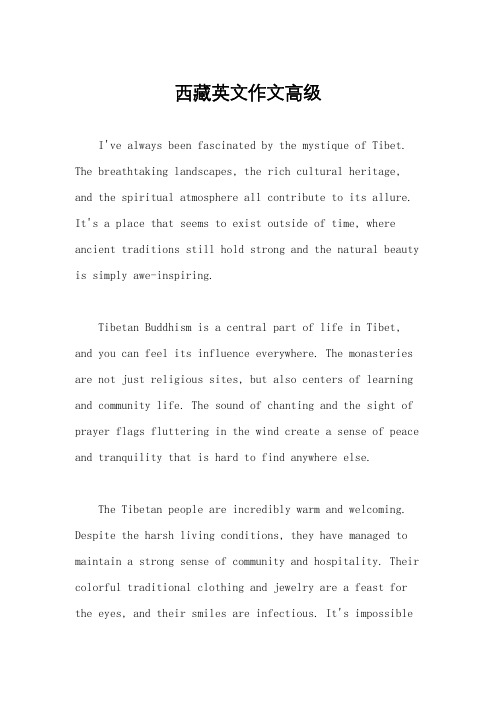
西藏英文作文高级I've always been fascinated by the mystique of Tibet. The breathtaking landscapes, the rich cultural heritage, and the spiritual atmosphere all contribute to its allure. It's a place that seems to exist outside of time, where ancient traditions still hold strong and the natural beauty is simply awe-inspiring.Tibetan Buddhism is a central part of life in Tibet, and you can feel its influence everywhere. The monasteries are not just religious sites, but also centers of learning and community life. The sound of chanting and the sight of prayer flags fluttering in the wind create a sense of peace and tranquility that is hard to find anywhere else.The Tibetan people are incredibly warm and welcoming. Despite the harsh living conditions, they have managed to maintain a strong sense of community and hospitality. Their colorful traditional clothing and jewelry are a feast for the eyes, and their smiles are infectious. It's impossiblenot to be moved by their resilience and strength in the face of adversity.The Tibetan plateau is one of the most stunning and diverse landscapes on the planet. From the towering peaks of the Himalayas to the crystal-clear lakes and lush valleys, every corner of Tibet seems to be touched by the hand of a higher power. It's a place that demands to be explored, to be experienced in all its raw, untamed beauty.One of the most unforgettable experiences in Tibet is witnessing the annual Saga Dawa festival. It's a time of great celebration and spiritual significance, as thousands of pilgrims make their way to Lhasa to pay homage to the Buddha. The atmosphere is electric, with colorful processions, traditional music and dance, and a palpable sense of devotion and joy.Tibet is a place that leaves an indelible mark on your soul. It's a place of contrasts, where the modern world meets ancient traditions, and where the harshness of nature is softened by the warmth of the people. It's a place thatchallenges your perceptions and opens your heart to new ways of seeing and being. I can't wait to return and continue my exploration of this extraordinary land.。
西藏历史书 英文版pdf
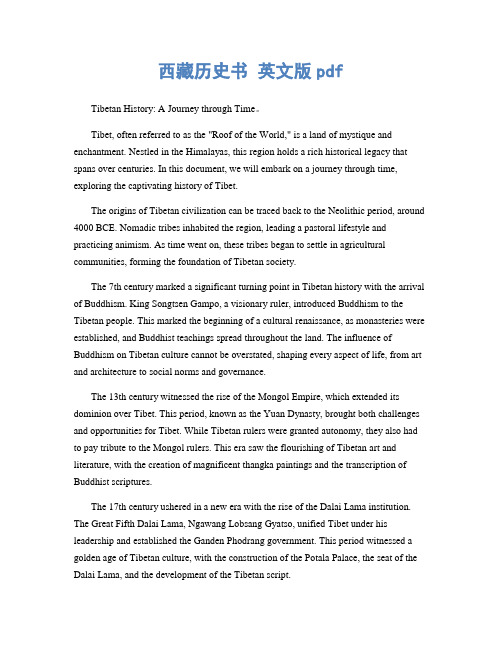
西藏历史书英文版pdfTibetan History: A Journey through Time。
Tibet, often referred to as the "Roof of the World," is a land of mystique and enchantment. Nestled in the Himalayas, this region holds a rich historical legacy that spans over centuries. In this document, we will embark on a journey through time, exploring the captivating history of Tibet.The origins of Tibetan civilization can be traced back to the Neolithic period, around 4000 BCE. Nomadic tribes inhabited the region, leading a pastoral lifestyle and practicing animism. As time went on, these tribes began to settle in agricultural communities, forming the foundation of Tibetan society.The 7th century marked a significant turning point in Tibetan history with the arrival of Buddhism. King Songtsen Gampo, a visionary ruler, introduced Buddhism to the Tibetan people. This marked the beginning of a cultural renaissance, as monasteries were established, and Buddhist teachings spread throughout the land. The influence of Buddhism on Tibetan culture cannot be overstated, shaping every aspect of life, from art and architecture to social norms and governance.The 13th century witnessed the rise of the Mongol Empire, which extended its dominion over Tibet. This period, known as the Yuan Dynasty, brought both challenges and opportunities for Tibet. While Tibetan rulers were granted autonomy, they also had to pay tribute to the Mongol rulers. This era saw the flourishing of Tibetan art and literature, with the creation of magnificent thangka paintings and the transcription of Buddhist scriptures.The 17th century ushered in a new era with the rise of the Dalai Lama institution. The Great Fifth Dalai Lama, Ngawang Lobsang Gyatso, unified Tibet under his leadership and established the Ganden Phodrang government. This period witnessed a golden age of Tibetan culture, with the construction of the Potala Palace, the seat of the Dalai Lama, and the development of the Tibetan script.However, the 20th century brought immense challenges for Tibet. In 1950, the People's Republic of China claimed sovereignty over Tibet, leading to a series of political and cultural upheavals. The Tibetan people faced restrictions on their religious practices, and the Dalai Lama was forced into exile in 1959. The subsequent years witnessed protests, resistance, and a struggle for Tibetan independence.Despite the challenges faced by Tibet, its rich cultural heritage continues to thrive. Tibetan Buddhism has spread across the globe, captivating the hearts and minds of people from all walks of life. Tibetan art, with its intricate thangka paintings and vibrant mandalas, continues to inspire awe and admiration.In recent years, efforts have been made to preserve and promote Tibetan culture. Tibetan language schools have been established, and cultural festivals are celebrated with vigor. The Tibetan diaspora has played a crucial role in keeping the flame of Tibetan identity alive, with communities thriving in various parts of the world.As we conclude our journey through Tibetan history, we are reminded of the resilience and spirit of the Tibetan people. Their unwavering devotion to their culture and religion serves as a testament to the power of human determination. Tibet's history is not just a story of conquest and struggle; it is a tale of a civilization that has withstood the test of time, leaving an indelible mark on the world.In conclusion, the history of Tibet is a tapestry woven with threads of spirituality, culture, and resilience. From its ancient origins to its modern-day challenges, Tibet's story is one of triumph over adversity. As we delve into the pages of Tibetan history, we gain a deeper understanding of this extraordinary land and its people. Let us cherish and honor the legacy of Tibet, ensuring that its vibrant history continues to inspire generations to come.。
西藏英文介绍

西藏英文介绍Nestled in the heart of the Himalayas, Tibet Autonomous Region of China is a land of breathtaking natural beauty and profound cultural heritage. Spanning an area of over 1.2 million square kilometers, Tibet boasts a diverse landscape ranging from snow-capped mountains to vast grasslands, desolate deserts, and crystal-clear lakes.The region is famous for its unique geography, which includes the world's highest peak, Mount Everest, and several other notable mountains. The high altitude and harsh climate of Tibet have given it a unique ecological system, home to a vast array of wildlife including snow leopards, yaks, and Tibetan antelopes.Despite its remoteness and inaccessibility, Tibet has always been a land of rich cultural and religious traditions. The Tibetan people, who trace their ancestry back to ancient civilizations, have preserved their unique language, script, and way of life. Tibetan Buddhism, with its unique philosophy and practices, has a profound influence on the region's culture and society.The capital city of Lhasa, located in the southern part of Tibet, is a testament to the region's rich cultural heritage. The Potala Palace, a magnificent structure built in the 7th century, is a symbol of Tibetan architecture and art. The city is also famous for its monasteries, including the Jokhang Temple, which is considered the holiest placein Tibetan Buddhism.In recent years, Tibet has attracted increasing attention from tourists and adventurers from around the world. While the region's unique natural beauty remains a major draw, it is also becoming known for its unique cultural experiences. Visitors can participate intraditional festivals, learn about Tibetan medicine and astrology, and even try their hand at traditional crafts like carpet weaving and metalworking.Despite the challenges posed by its remote location and harsh climate, Tibet remains a land of boundless beauty and mystery. Its rich cultural heritage and unique natural landscapes make it a must-visit destination for travelers seeking a truly authentic and memorable experience.**西藏:神秘魅力的雪域高原**位于中国喜马拉雅山脉心脏地带的西藏自治区,是一个拥有令人叹为观止的自然美景和深厚文化遗产的土地。
西藏英文介绍简单
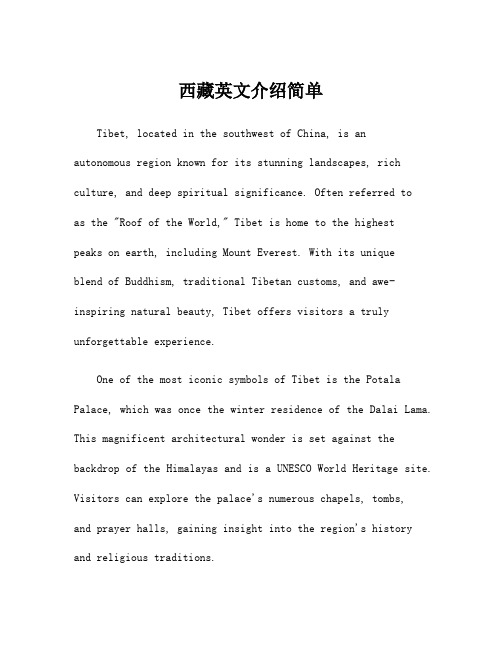
西藏英文介绍简单Tibet, located in the southwest of China, is an autonomous region known for its stunning landscapes, rich culture, and deep spiritual significance. Often referred toas the "Roof of the World," Tibet is home to the highestpeaks on earth, including Mount Everest. With its uniqueblend of Buddhism, traditional Tibetan customs, and awe-inspiring natural beauty, Tibet offers visitors a truly unforgettable experience.One of the most iconic symbols of Tibet is the Potala Palace, which was once the winter residence of the Dalai Lama. This magnificent architectural wonder is set against the backdrop of the Himalayas and is a UNESCO World Heritage site. Visitors can explore the palace's numerous chapels, tombs,and prayer halls, gaining insight into the region's history and religious traditions.Another must-see destination in Tibet is the Jokhang Temple, an important pilgrimage site for Tibetan Buddhists. Located in the heart of Lhasa, the temple is a vibrant center of religious activity, with locals and monks coming to worship and conduct rituals. Its architectural style, with a mix of Indian, Nepalese, and Han Chinese influences, reflects the cultural diversity of Tibet.For those seeking adventure, Tibet offers a wealth of outdoor activities and unforgettable natural wonders. The region is home to some of the world's most breathtaking landscapes, from soaring mountain peaks to crystal-clear lakes and lush valleys. Trekkers can embark on the world-renowned Everest Base Camp trek, while nature enthusiasts can visit Yamdrok Lake, one of the three largest sacred lakes in Tibet, known for its stunning turquoise waters and surrounding snow-capped mountains.Tibetan cuisine is another highlight of the region, known for its unique flavors and use of local ingredients. Traditional dishes such as yak meat, butter tea, and momos (dumplings) offer visitors a taste of authentic Tibetan culture. Visitors can also explore local markets and handicraft shops to purchase handmade goods, including intricately woven carpets, traditional clothing, and vibrant religious art.In addition to its natural beauty and cultural heritage, Tibet is a place of deep spiritual significance. Tibetan Buddhism permeates every aspect of life in the region, with countless monasteries and temples serving as centers of worship and meditation. One of the most famous of these is the Sera Monastery, where visitors can witness the daily debates among monks and gain insight into the practice of Buddhism.However, traveling to Tibet requires some advance planning due to the region's unique political and geographical challenges. Visitors must obtain a specialtravel permit from the Chinese government in addition to a Chinese tourist visa. It's advisable to book tours through a reputable travel agency that can provide guidance and support throughout the trip.In conclusion, Tibet is a land of unparalleled beauty, spirituality, and cultural richness. From its ancient monasteries and palaces to its stunning landscapes andvibrant traditions, Tibet offers a truly unique and enriching experience for travelers. Whether seeking adventure in the great outdoors or spiritual enlightenment in ancient temples, a journey to Tibet is sure to leave a lasting impression.。
西藏传统文化 英文介绍

西藏传统文化英文介绍Tibet, a mystical land nestled in the heart of the Himalayas, boasts a rich and ancient cultural heritage that has been preserved and nurtured for centuries. This unique blend of Buddhism, mythology, folklore, and nomadic traditions forms the cornerstone of Tibetan culture, which continues to captivate and inspire people from all corners of the world.Buddhism in TibetBuddhism, particularly the Vajrayana (Tibetan Buddhism), is the dominant religion in Tibet, deeply intertwined with its social, political, and cultural fabric. The Dalai Lamas, the spiritual leaders of Tibet, have played a pivotal role in preserving and propagating Buddhist teachings. Tibetan Buddhism comprises various schools, including the Nyingma, Kagyu, Sakya, and Gelug, each with its unique practices, rituals, and lineages of meditation masters.Monasteries, known as gompas, dot the Tibetan landscape, serving as centers of learning, meditation, and worship. Inside these serene sanctuaries, intricate mandalas, thangkas (religious paintings), and statues ofdeities adorn the walls and altars, reflecting theintricate symbolism and artistic prowess of Tibetan Buddhism.Tibetan Art and ArchitectureTibetan art is renowned for its intricate designs, vibrant colors, and profound spiritual significance. Thangkas, sand mandalas, and sculptures are among the most recognizable forms of Tibetan art, each imbued with deep religious and cultural meanings. These works often depict Buddhist deities, mythological creatures, and sacred landscapes, conveying the essence of Buddhist teachings and beliefs.Tibetan architecture, too, reflects a blend of Buddhist ideals and local traditions. Gompas, monasteries, and temples are constructed with meticulous attention to detail, featuring ornate exteriors adorned with intricate carvings and paintings, as well as spacious interiors designed to facilitate meditation and religious ceremonies.Folklore and FestivalsTibetan folklore is rich in tales of gods, demons, heroes, and saints, passed down through generations through oral traditions and storytelling. These stories often serveas a means of preserving cultural identity, moral guidance, and spiritual enlightenment.Tibet also celebrates a variety of festivals throughout the year, each marking significant events in the Buddhist calendar or commemorating historical figures and events. The Losar (Tibetan New Year) is perhaps the most widely known, during which families gather to feast, exchange gifts, and engage in traditional activities like making "tsampa" (a type of barley flour) and throwing "glug" (wheat flour) at each other for good luck.Nomadic TraditionsFor centuries, Tibet has been home to nomadic tribes who have lived in harmony with the harsh yet breathtaking landscapes of the plateau. Their way of life, centered around herding yaks, sheep, and goats, has shaped their culture, beliefs, and customs. Nomadic dwellings, such as yurts (known as "ger" in Mongolia and "khacha" in Tibet), are portable structures that allow for easy relocation in search of grazing lands.The nomadic lifestyle is rich in traditions, including elaborate wedding ceremonies, intricate rituals surrounding the birth of livestock, and unique forms of music, dance,and storytelling that reflect the rhythm and pace of life on the open plains.In conclusion, Tibetan culture is a vibrant and diverse tapestry woven from the threads of Buddhism, art, folklore, festivals, and nomadic traditions. It is a testament to the resilience and ingenuity of the Tibetan people, who have preserved and nurtured their cultural heritage amidst the challenges of time and geography.。
Tibet西藏英文介绍
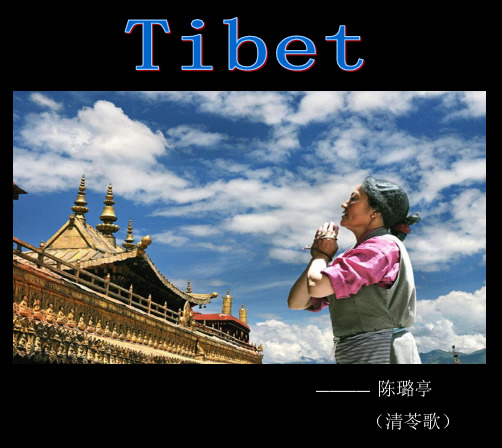
T——Touch 触摸/ Towards 向,朝, 将近
I——Inspire 使……产生灵感/ I 我
B——Best 最好的/ Belief
T——Temple 寺庙,神庙/ Terrific 极好的/ the Holy land 圣地
Yarlung Zangbo Grand Canyon
(雅鲁藏布大峡谷)
The Yarlung Zangbo Grand Canyon is one of the deepest and longest canyons in the world. The canyon is home to many animals and plants barely explored and affected by human influence, while its climate ranges from subtropical to Arctic.
The main religion in Tibet is Lamaism.
Kowtow(磕长头)
Tibetans believe that in the life practice Buddhism, at least to knock one hundred thousand(100000) long head, all barefoot, that is pious.
Namtso Lake(纳木措)
Namtso is one of the three holy lakes in Tibet Autonomous Region and should not be missed by any traveler to Tibet. In Tibetan, Namtso means “Heavenly Lake.” It is famous for its high altitude and imposing scenery.
介绍西藏英文作文

介绍西藏英文作文英文:Tibet, also known as the "Roof of the World," is a region located on the Tibetan Plateau in Asia. It is a place of breathtaking natural beauty, rich cultural heritage, and unique traditions. I had the opportunity to visit Tibet last year, and it was an experience that left a lasting impression on me.One of the first things that struck me about Tibet was its stunning landscapes. The towering Himalayas, crystal-clear lakes, and vast grasslands all contributed to the region's otherworldly beauty. I remember standing at the base of Mount Everest, feeling incredibly small in its presence. The sheer magnitude of the mountains and the tranquility of the surrounding landscape left me in awe.In addition to its natural beauty, Tibet is also home to a rich and vibrant culture. During my visit, I had thechance to attend a traditional Tibetan festival, where I witnessed colorful dances, intricate costumes, and mesmerizing music. The warmth and hospitality of the Tibetan people were truly heartwarming, and I felt privileged to be able to partake in their celebrations.Another aspect of Tibetan culture that fascinated me was its unique religious practices. The region is home to many sacred sites, including the iconic Potala Palace and Jokhang Temple. I was struck by the devotion andspirituality of the Tibetan people, and I found their reverence for their religious traditions to be deeply inspiring.One of the most memorable experiences of my trip was visiting a local Tibetan family. They welcomed me intotheir home, offering me traditional butter tea and sharing stories about their way of life. It was a humbling experience to see firsthand how the Tibetan people live and to gain insight into their customs and traditions.Overall, my time in Tibet was an unforgettable journeythat opened my eyes to a world of natural beauty andcultural richness. The region's awe-inspiring landscapes, vibrant traditions, and warm-hearted people left a deep impression on me, and I left with a newfound appreciationfor this extraordinary corner of the world.中文:西藏,被誉为“世界屋脊”,位于亚洲的青藏高原上。
介绍西藏英文作文

介绍西藏英文作文Tibet, also known as the "Roof of the World", is a region located in the southwest of China. It is renownedfor its stunning landscapes, including the majestic Himalayas, vast grasslands, and crystal-clear lakes.The unique culture of Tibet is deeply rooted in Tibetan Buddhism, which has greatly influenced the local art, architecture, and way of life. The colorful prayer flags fluttering in the wind, the intricate murals in the monasteries, and the devout pilgrims prostrating themselves along the kora are all emblematic of Tibetan spirituality.Tibetan cuisine is another highlight of the region, featuring hearty dishes such as yak meat, tsampa (roasted barley flour), and butter tea. The cuisine reflects the harsh climate and high altitude of the plateau, providing sustenance and warmth to the Tibetan people.The traditional Tibetan clothing, known as chuba, is adistinctive feature of the local attire. The long, thick robe is well-suited to the cold weather and serves as a symbol of Tibetan identity and heritage.Tibetan festivals, such as Losar (Tibetan New Year) and Saga Dawa (commemorating the birth, enlightenment, and death of Buddha), are vibrant celebrations filled with music, dance, and religious rituals. These festivals offer a glimpse into the rich cultural traditions of the Tibetan people.The Potala Palace, once the winter residence of the Dalai Lama, is a UNESCO World Heritage site and a symbol of Tibetan history and architecture. Its grandeur andspiritual significance make it a must-visit destination for travelers to Tibet.Trekking and mountaineering are popular activities in Tibet, attracting adventure enthusiasts from around the world. The challenging terrain and breathtaking views make it an unforgettable experience for those seeking outdoor adventure.Overall, Tibet is a land of immense natural beauty, rich cultural heritage, and spiritual significance. It continues to captivate and inspire visitors with its awe-inspiring landscapes and profound traditions.。
关于西藏介绍的英文作文
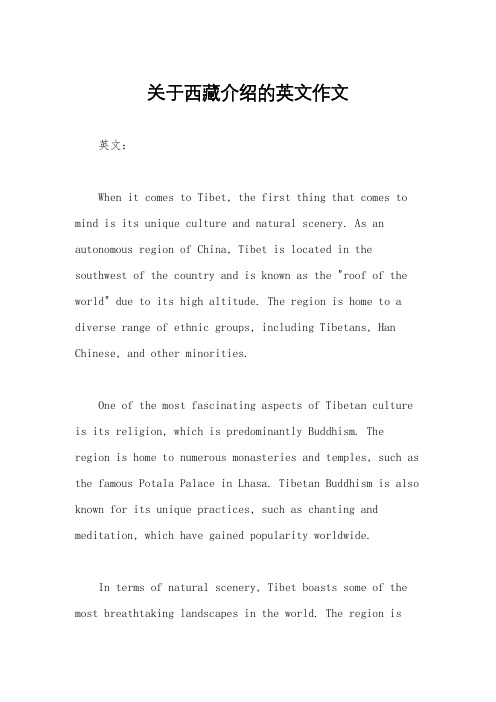
关于西藏介绍的英文作文英文:When it comes to Tibet, the first thing that comes to mind is its unique culture and natural scenery. As an autonomous region of China, Tibet is located in the southwest of the country and is known as the "roof of the world" due to its high altitude. The region is home to a diverse range of ethnic groups, including Tibetans, Han Chinese, and other minorities.One of the most fascinating aspects of Tibetan culture is its religion, which is predominantly Buddhism. The region is home to numerous monasteries and temples, such as the famous Potala Palace in Lhasa. Tibetan Buddhism is also known for its unique practices, such as chanting and meditation, which have gained popularity worldwide.In terms of natural scenery, Tibet boasts some of the most breathtaking landscapes in the world. The region ishome to the highest mountain in the world, Mount Everest, as well as numerous other peaks and ranges. There are also many lakes, rivers, and grasslands that are home to a variety of wildlife.Overall, Tibet is a truly unique and fascinating region that is definitely worth visiting. Whether you are interested in culture, religion, or nature, there is something for everyone to enjoy.中文:谈到西藏,人们首先想到的是其独特的文化和自然风光。
西藏的文化介绍英文作文
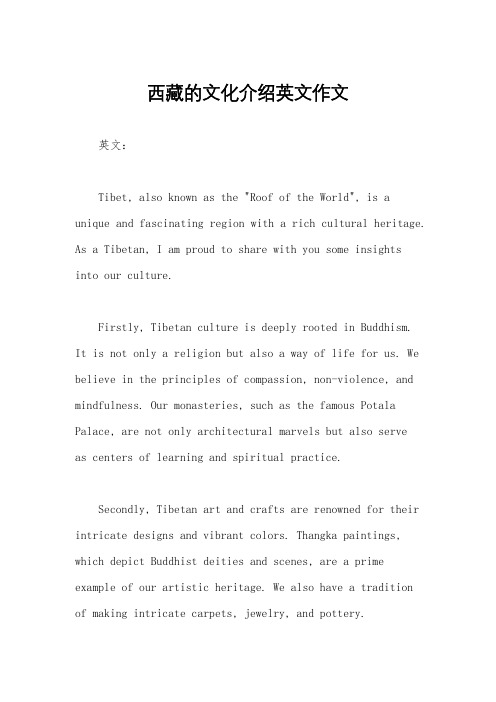
西藏的文化介绍英文作文英文:Tibet, also known as the "Roof of the World", is a unique and fascinating region with a rich cultural heritage. As a Tibetan, I am proud to share with you some insightsinto our culture.Firstly, Tibetan culture is deeply rooted in Buddhism.It is not only a religion but also a way of life for us. We believe in the principles of compassion, non-violence, and mindfulness. Our monasteries, such as the famous Potala Palace, are not only architectural marvels but also serveas centers of learning and spiritual practice.Secondly, Tibetan art and crafts are renowned for their intricate designs and vibrant colors. Thangka paintings, which depict Buddhist deities and scenes, are a prime example of our artistic heritage. We also have a traditionof making intricate carpets, jewelry, and pottery.Thirdly, Tibetan cuisine is unique and delicious. Our staple food is tsampa, a roasted barley flour, which we mix with butter tea to make a filling and nutritious meal. We also have a variety of meat and vegetable dishes, such as momos (dumplings) and thukpa (noodle soup).In terms of language, Tibetan is a complex and tonal language. We have different dialects and writing systems, such as the classical Tibetan script and the more modern Tibetan script. However, English is also widely spoken and understood in urban areas, especially among the younger generation.Overall, Tibetan culture is a treasure trove of history, art, and spirituality. It is a unique blend of ancient traditions and modern influences, and it continues toinspire and fascinate people from all over the world.中文:西藏,也被称为“世界屋脊”,是一个充满独特和迷人的文化遗产的地区。
西藏各地风情介绍英文作文
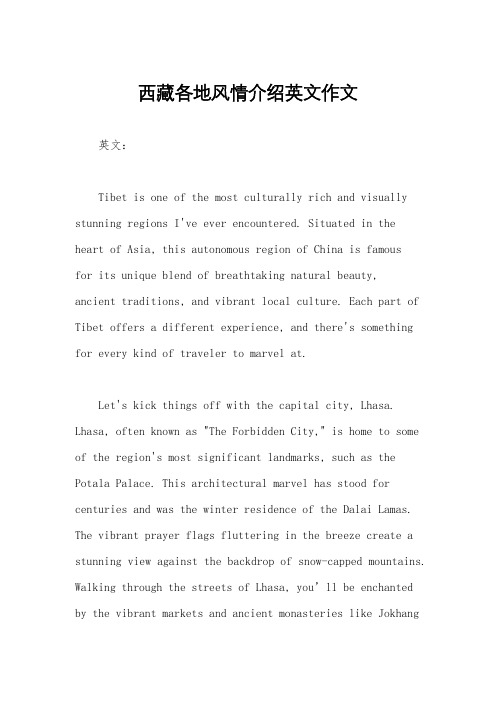
西藏各地风情介绍英文作文英文:Tibet is one of the most culturally rich and visually stunning regions I've ever encountered. Situated in theheart of Asia, this autonomous region of China is famousfor its unique blend of breathtaking natural beauty,ancient traditions, and vibrant local culture. Each part of Tibet offers a different experience, and there's something for every kind of traveler to marvel at.Let's kick things off with the capital city, Lhasa. Lhasa, often known as "The Forbidden City," is home to some of the region's most significant landmarks, such as the Potala Palace. This architectural marvel has stood for centuries and was the winter residence of the Dalai Lamas. The vibrant prayer flags fluttering in the breeze create a stunning view against the backdrop of snow-capped mountains. Walking through the streets of Lhasa, you’ll be enchanted by the vibrant markets and ancient monasteries like JokhangTemple, which is the spiritual heart of Tibetan Buddhism.Moving away from Lhasa, we can explore other notable places like Shigatse, the second-largest city in Tibet. It boasts attractions such as Tashilhunpo Monastery, a remarkable structure that houses the largest gilded Buddha statue in the world. Besides, the city is known for its annual Shoton Festival, a celebration that combines traditional opera, food, and religious activities.Another unmissable spot in Tibet is Nyingchi, often referred to as the "Switzerland of the East" for its picturesque landscapes of forests, rivers, and mountains. The peach blossom festival held annually in spring is a breathtaking experience. Imagine walking through miles of blooming peach trees while surrounded by snow-capped peaks and clear blue skies.On the opposite end of the spectrum is Mount Everest, the highest peak in the world, which can be accessed from the Tibetan side. The Everest Base Camp trek is a once-in-a-lifetime opportunity for adventurers and trekkers alike.The awe-inspiring views of the towering mountains are truly humbling.In addition to the natural beauty and historical sites, Tibetan culture is rich with traditions and customs thatcan be seen in daily life. The warmth and hospitality ofthe locals make the experience even more memorable. From sipping butter tea with a local family to participating ina traditional dance, visitors can immerse themselves in the way of life that has been preserved over centuries.Let's not forget about the food! Tibetan cuisine is unique, with influences from both Indian and Chinese cooking. Dishes like momos (dumplings), thukpa (noodle soup), and yak meat dishes are must-try experiences for anyone visiting the region.Traveling through Tibet, you'll find that every corner has its own story to tell. Whether it's the serene landscapes, the ancient monasteries, or the friendly locals, there's a certain magic to this place that can't be described in words alone. If you're a seeker of adventure,spirituality, or simply looking for an escape from thehustle and bustle of city life, Tibet is a destination you should definitely consider.中文:西藏是我遇到过的文化最丰富、视觉最惊艳的地区之一。
关于西藏的英文作文

关于西藏的英文作文全文共3篇示例,供读者参考篇1Tibet, also known as the "Roof of the World," is a region located in the southwestern part of China. With its breathtaking landscapes, rich cultural heritage, and unique traditions, Tibet has captivated the hearts of travelers and adventurers from all over the world. In this essay, we will delve into the diverse and fascinating aspects of Tibet, exploring its history, culture, and natural beauty.History of TibetTibet has a long and storied history that dates back thousands of years. The region was once a powerful empire that ruled over vast swathes of Central Asia. In the 7th century, Buddhism was introduced to Tibet, and it quickly became the dominant religion of the region. Over the centuries, Tibet developed a unique form of Buddhism known as Tibetan Buddhism, which is characterized by its colorful rituals, intricate artwork, and deep spiritual teachings.In the 13th century, Tibet came under the rule of the Mongol Empire, and later became a vassal state of the Chinese Qing Dynasty. In the early 20th century, Tibet declared independence from China, but was later occupied by Chinese forces in 1950. Since then, Tibet has been a point of contention between China and Tibetans seeking greater autonomy and independence.Culture of TibetTibetan culture is rich and diverse, influenced by its unique geography and history. The traditional Tibetan way of life revolves around Buddhism, with monasteries playing a central role in Tibetan society. Monks and nuns are highly respected members of the community, and their daily rituals and ceremonies are an integral part of Tibetan culture.Tibetan art and architecture are also highly distinctive, with intricate mandalas, thangka paintings, and colorful prayer flags adorning monasteries and homes. Tibetan music and dance are vibrant and lively, with traditional instruments such as the dranyen and damaru being used in religious ceremonies and festivals.One of the most well-known aspects of Tibetan culture is the annual Tibetan New Year festival, known as Losar. During this festival, Tibetans engage in religious rituals, colorful parades,traditional dances, and feasts to celebrate the new year. Another important festival is the Shoton Festival, which celebrates the end of the fasting season for monks and features opera performances, yak racing, and picnics.Natural Beauty of TibetTibet is known for its stunning natural landscapes, from towering Himalayan peaks to vast grasslands and shimmering lakes. One of the most iconic sights in Tibet is Mount Everest, the highest peak in the world, which attracts climbers and trekkers from around the globe. Other famous peaks in Tibet include Cho Oyu, Shishapangma, and Lhotse.Tibet is also home to several sacred lakes, such as Yamdrok Lake, Namtso Lake, and Lake Manasarovar. These crystal-clear lakes are considered holy by Tibetans, and pilgrims come from far and wide to circumambulate their shores and offer prayers.The Tibetan Plateau, often referred to as the "Roof of the World," is the largest and highest plateau on Earth. It is characterized by rugged terrain, high-altitude deserts, and snow-capped mountains. Despite its harsh climate and sparse vegetation, the Tibetan Plateau is home to a diverse range of wildlife, including Tibetan antelope, Himalayan bears, and snow leopards.ConclusionIn conclusion, Tibet is a truly unique and fascinating region that offers a wealth of cultural, historical, and natural attractions. From its ancient monasteries and vibrant festivals to its towering mountains and pristine lakes, Tibet is a place of unparalleled beauty and spirituality. Whether you are a history buff, a nature lover, or a spiritual seeker, Tibet is sure to capture your imagination and leave you in awe of its timeless beauty.篇2Tibet, also known as the "Roof of the World", is a land of mystique, beauty, and spirituality. Located in the remote Himalayas, Tibet is an autonomous region of China and is home to a unique culture, language, and way of life.Tibet is a place of incredible natural beauty, with towering snow-capped mountains, vast grasslands, and crystal-clear lakes. The region is also home to some of the world's highest peaks, including Mount Everest, which straddles the border between Tibet and Nepal. The landscapes of Tibet are truly awe-inspiring, and visitors to the region are often left breathless by the sheer majesty of the scenery.In addition to its natural beauty, Tibet is also a place of great spiritual significance. The region is the traditional home of Tibetan Buddhism, a unique form of Buddhism that has its roots in both Indian and Chinese Buddhist traditions. Tibet is home to numerous monasteries, temples, and sacred sites, many of which have been in existence for hundreds of years. These spiritual sites are not only places of worship, but also centers of learning, meditation, and reflection.One of the most famous spiritual sites in Tibet is the Potala Palace in the capital city of Lhasa. This iconic building was once the winter residence of the Dalai Lama, the spiritual leader of Tibetan Buddhism. The palace is now a museum and UNESCO World Heritage Site, attracting thousands of visitors each year who come to marvel at its beauty and learn about its history.In recent years, Tibet has become an increasingly popular destination for tourists from around the world. The region's unique culture, stunning landscapes, and spiritual heritage make it a truly special place to visit. Whether you are interested in hiking in the mountains, exploring ancient monasteries, or simply experiencing the tranquility of the Tibetan way of life, Tibet has something to offer everyone.However, Tibet is also a region that faces many challenges. The political situation in Tibet is complex, with ongoing tensions between the Chinese government and supporters of Tibetan independence. Human rights issues are also a concern, with reports of restrictions on freedom of speech and religion in the region. Despite these challenges, Tibet remains a place of great beauty, spirituality, and resilience.In conclusion, Tibet is a land of mystery and wonder, a place where ancient traditions and modern realities come together in a unique and fascinating way. Whether you are a spiritual seeker, a nature lover, or simply someone looking for a new and exciting travel destination, Tibet has something to offer you. Visit this incredible region and experience the magic of the Roof of the World for yourself.篇3***Tibet: The Roof of the World***Located in the southwest of China, Tibet is a region on the Tibetan Plateau known as the "Roof of the World" due to its high altitude and stunning landscapes. With a rich cultural heritage, unique traditions, and breathtaking natural scenery, Tibet is aplace that captivates the hearts of travelers from around the world.Tibet is home to the Tibetan people, who have a strong connection to their land and their religion, Tibetan Buddhism. Monasteries such as the Potala Palace in Lhasa, the Jokhang Temple, and the Sera Monastery are important religious sites and architectural wonders that attract pilgrims and tourists alike. The Dalai Lama, the spiritual leader of Tibetan Buddhism, has long been a symbol of peace and compassion, with followers around the globe.In addition to its religious sites, Tibet is also known for its stunning natural beauty. The region is dotted with snow-capped mountains, pristine lakes, and vast grasslands that seem to stretch on forever. The Himalayas, including the world's highest peak, Mount Everest, are a prominent feature of the Tibetan landscape, drawing adventurers and mountaineers from all corners of the globe.The Tibetan people have a rich cultural heritage that is reflected in their arts, cuisine, and festivals. Traditional Tibetan music, dance, and art forms have been passed down through generations, with intricate patterns and vibrant colors adorning everything from clothing to prayer flags. Tibetan cuisine, with itshearty dishes and unique flavors, is a true reflection of the region's harsh climate and nomadic lifestyle.One of the most famous festivals in Tibet is the Tibetan New Year, or Losar, which is celebrated with colorful parades, traditional dances, and religious ceremonies. Another important festival is the Saga Dawa, which commemorates the Buddha's birth, enlightenment, and death. Pilgrims flock to sacred sites such as Mount Kailash and Lake Manasarovar during this time to perform kora, a religious practice of walking around these holy sites.Despite its natural beauty and cultural richness, Tibet has faced challenges in recent years, including political unrest and environmental concerns. The region has been the subject of controversy due to its complex relationship with China and calls for greater autonomy and religious freedom. The fragile ecosystem of Tibet, which is home to rare species such as the Tibetan antelope and snow leopard, is also under threat from climate change and human activities.In conclusion, Tibet is a land of contrasts, where ancient traditions and modern challenges coexist. Whether you are drawn to its spiritual sites, majestic mountains, or vibrant culture, Tibet offers a unique and unforgettable experience for visitors.As we continue to explore and learn more about this enigmatic region, let us remember to tread lightly and respect the delicate balance of nature and culture that makes Tibet so special.。
西藏英文介绍小作文
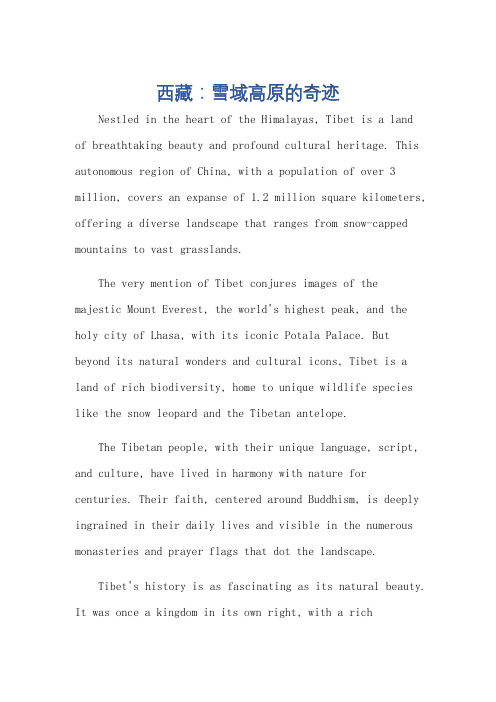
西藏:雪域高原的奇迹Nestled in the heart of the Himalayas, Tibet is a landof breathtaking beauty and profound cultural heritage. This autonomous region of China, with a population of over 3 million, covers an expanse of 1.2 million square kilometers, offering a diverse landscape that ranges from snow-capped mountains to vast grasslands.The very mention of Tibet conjures images of the majestic Mount Everest, the world's highest peak, and the holy city of Lhasa, with its iconic Potala Palace. But beyond its natural wonders and cultural icons, Tibet is a land of rich biodiversity, home to unique wildlife species like the snow leopard and the Tibetan antelope.The Tibetan people, with their unique language, script, and culture, have lived in harmony with nature for centuries. Their faith, centered around Buddhism, is deeply ingrained in their daily lives and visible in the numerous monasteries and prayer flags that dot the landscape.Tibet's history is as fascinating as its natural beauty. It was once a kingdom in its own right, with a richcultural heritage that dates back over 2,000 years. The introduction of Buddhism in the 7th century AD marked a turning point in Tibetan history, and the influence of this religion can be seen in every aspect of Tibetan life.Today, Tibet has emerged as a popular tourist destination, attracting visitors from all over the world. However, the region faces challenges such as environmental degradation and the preservation of its unique cultural heritage. Efforts are being made to address these issues while promoting sustainable tourism that respects the local culture and environment.The people of Tibet are proud of their heritage and are committed to preserving it for future generations. They welcome visitors with open arms, eager to share their culture and way of life with the world.**西藏:雪域高原上的璀璨明珠**西藏,坐落于喜马拉雅山脉的心脏地带,是一个拥有令人叹为观止的美景和深厚文化遗产的土地。
关于藏族的英文作文
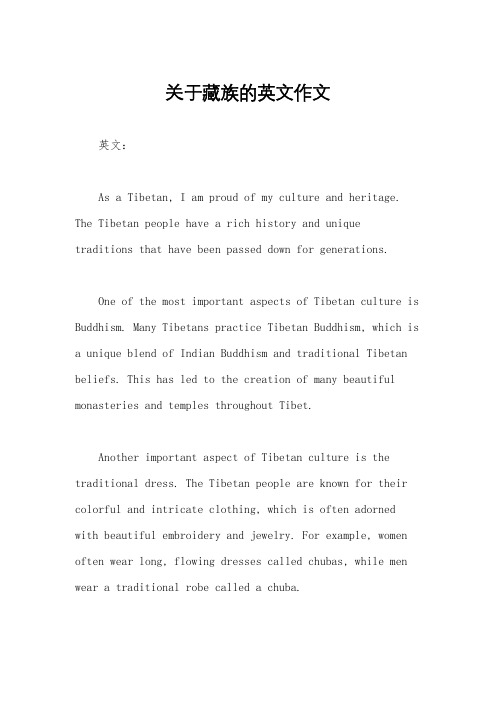
关于藏族的英文作文英文:As a Tibetan, I am proud of my culture and heritage. The Tibetan people have a rich history and uniquetraditions that have been passed down for generations.One of the most important aspects of Tibetan culture is Buddhism. Many Tibetans practice Tibetan Buddhism, which is a unique blend of Indian Buddhism and traditional Tibetan beliefs. This has led to the creation of many beautiful monasteries and temples throughout Tibet.Another important aspect of Tibetan culture is the traditional dress. The Tibetan people are known for their colorful and intricate clothing, which is often adorned with beautiful embroidery and jewelry. For example, women often wear long, flowing dresses called chubas, while men wear a traditional robe called a chuba.Food is also an important part of Tibetan culture. One of the most popular dishes is momos, which are steamed dumplings filled with meat or vegetables. Another popular dish is thukpa, which is a hearty noodle soup that is perfect for the cold Tibetan winters.Despite the beauty and richness of Tibetan culture, it has faced many challenges over the years. The Chinese government has imposed strict restrictions on Tibetan culture and religion, and many Tibetans have been forced to flee their homeland.However, despite these challenges, Tibetans continue to preserve and celebrate their culture. Through music, dance, and other forms of art, Tibetans are able to express their unique identity and keep their traditions alive.中文:作为一名藏族人,我为自己的文化和传统感到自豪。
西藏英文介绍小作文
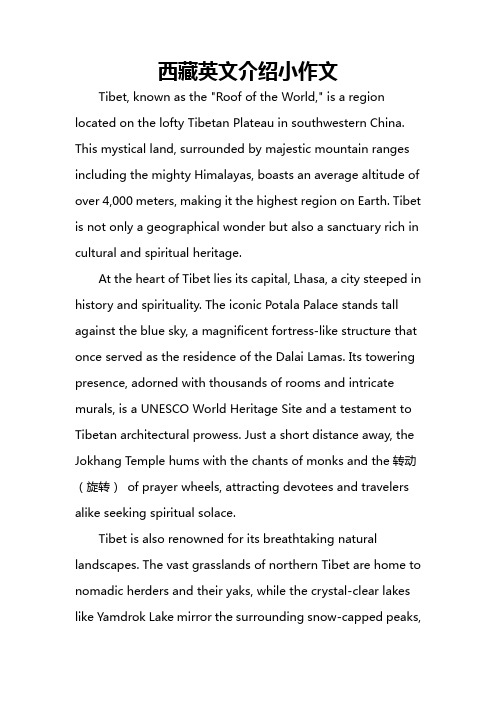
西藏英文介绍小作文Tibet, known as the "Roof of the World," is a region located on the lofty Tibetan Plateau in southwestern China. This mystical land, surrounded by majestic mountain ranges including the mighty Himalayas, boasts an average altitude of over 4,000 meters, making it the highest region on Earth. Tibet is not only a geographical wonder but also a sanctuary rich in cultural and spiritual heritage.At the heart of Tibet lies its capital, Lhasa, a city steeped in history and spirituality. The iconic Potala Palace stands tall against the blue sky, a magnificent fortress-like structure that once served as the residence of the Dalai Lamas. Its towering presence, adorned with thousands of rooms and intricate murals, is a UNESCO World Heritage Site and a testament to Tibetan architectural prowess. Just a short distance away, the Jokhang Temple hums with the chants of monks and the转动(旋转)of prayer wheels, attracting devotees and travelers alike seeking spiritual solace.Tibet is also renowned for its breathtaking natural landscapes. The vast grasslands of northern Tibet are home to nomadic herders and their yaks, while the crystal-clear lakes like Yamdrok Lake mirror the surrounding snow-capped peaks,creating a scene of unparalleled serenity. Mount Everest, or Qomolangma as it's known locally, straddles the border between Tibet and Nepal, drawing adventurers and mountaineers who aspire to conquer the world's highest peak.The Tibetan people, with their distinct culture and traditions, add to the allure of this region. Their vibrant festivals, such as the Shoton Festival (Yogurt Festival) and Losar (Tibetan New Year), showcase a vibrant tapestry of song, dance, and rituals that reflect their deep-rooted Buddhist beliefs. The warm hospitality of the Tibetans, often offering butter tea and momos (dumplings) to guests, is legendary.Despite modernization, Tibet has managed to preserve its unique identity, making it a destination unlike any other. For those seeking a journey of self-discovery or simply to marvel at nature's grandeur, Tibet offers a pilgrimage of both the body and soul. The untouched wilderness, ancient monasteries resonating with chants, and the ever-smiling faces of its people combine to create a truly unforgettable experience in this remote corner of the world.。
西藏简介英文作文
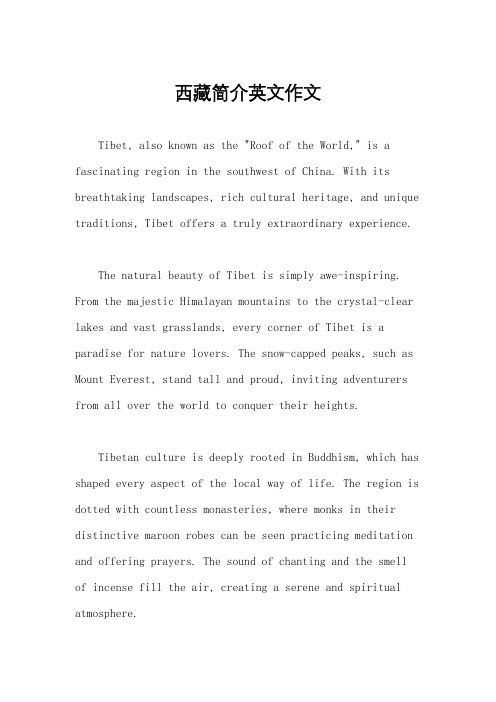
西藏简介英文作文Tibet, also known as the "Roof of the World," is a fascinating region in the southwest of China. With its breathtaking landscapes, rich cultural heritage, and unique traditions, Tibet offers a truly extraordinary experience.The natural beauty of Tibet is simply awe-inspiring. From the majestic Himalayan mountains to the crystal-clear lakes and vast grasslands, every corner of Tibet is a paradise for nature lovers. The snow-capped peaks, such as Mount Everest, stand tall and proud, inviting adventurers from all over the world to conquer their heights.Tibetan culture is deeply rooted in Buddhism, which has shaped every aspect of the local way of life. The region is dotted with countless monasteries, where monks in their distinctive maroon robes can be seen practicing meditation and offering prayers. The sound of chanting and the smell of incense fill the air, creating a serene and spiritual atmosphere.Tibetan people are known for their warm hospitality and genuine kindness. They welcome visitors with open arms, eager to share their unique customs and traditions. The vibrant festivals, such as the Tibetan New Year and the Shoton Festival, showcase the colorful costumes,traditional dances, and joyful celebrations that are an integral part of Tibetan culture.The traditional Tibetan cuisine is a delight for food enthusiasts. Yak meat, butter tea, and tsampa (roasted barley flour) are some of the signature dishes that reflect the region's high-altitude lifestyle. The flavors are bold and hearty, providing sustenance for the harsh Tibetan winters.Tibet's history is filled with tales of conquests, spiritual leaders, and political struggles. The Potala Palace, once the winter residence of the Dalai Lama, stands as a symbol of Tibetan sovereignty and resilience. Its grand architecture and intricate artwork are a testament to the rich history and cultural heritage of Tibet.Trekking through the remote valleys and exploring the hidden gems of Tibet is an adventure like no other. The nomadic herders, grazing yaks on the vast grasslands, provide a glimpse into a way of life that has remained unchanged for centuries. The tranquil beauty of the Tibetan plateau is a place where one can find solace and connect with nature.In conclusion, Tibet is a land of wonders that captivates the hearts of all who visit. Its majestic landscapes, vibrant culture, and warm-hearted people make it a destination that is truly unique. Whether you are seeking adventure, spiritual enlightenment, or simply a chance to immerse yourself in a different world, Tibet has something to offer for everyone.。
- 1、下载文档前请自行甄别文档内容的完整性,平台不提供额外的编辑、内容补充、找答案等附加服务。
- 2、"仅部分预览"的文档,不可在线预览部分如存在完整性等问题,可反馈申请退款(可完整预览的文档不适用该条件!)。
- 3、如文档侵犯您的权益,请联系客服反馈,我们会尽快为您处理(人工客服工作时间:9:00-18:30)。
Environmentalists say that sky burials are good for the environment because no wood is burned, no water is fouled and no space is used up.
Please keep quiet on the top of mountains. It is believed
Do not receive or give a gift with only a hand. While presenting the
gift, you should bend your body forward and hold the gift higher than your heБайду номын сангаасd with both hands.
Lamaist devil dance跳神会
Festivals
The Shoton festival (雪顿节/展佛节) It is also called the Yogurt Festival, happened on July 1st in the Tibetan calendar.
The festival mainly consists of 3 parts - Great Buddha Display, Tibetan Opera Show and Horsemanship & Yak Race Show. In combination they represent the best of Tibetan religion, culture and tradition.
When the host presents you
a cup of wine; you should dip your ring finger in the wine and flick the wine into the sky, in the air and to the ground respectively to express your respects to the heaven, the earth and the ancestors before sipping the wine. The host will fill the cup, and you take a sip of the wine again. After the host fills your cup for the forth time, you have to bottom it up.
Tibet culture
Culture
festivals folkways
Festivals
Losar
(The Tibetan New Year)---藏历新年
Losar
is celebrated for 15 days, with the main celebrations on the first three days. & It is the most important festival in Tibet. and there will be a week long drama and carnivals, horse races and archery.
Folkways--- Funerals
The
Tibetans have five ways of disposing of the dead bodies: 1) Water Burial;(水葬) 2) Sky Burial; (天葬) 3) Fire Burial;(火葬) 4) Earth Burial; (土葬) 5) Embalming(尸体防腐)
Folkways
Tibetans
is an old and passionate ethnic minority. During the long history, Tibetans have formed their own customs and taboos. With unique culture and religion, Tibetans have different ways of behavior in many aspects.
How to behave in Tibet?
About
daily life
Tibetan people do not eat horse, dog and donkey meat and also do not eat fish in some areas, so please respect their diet habits. that loud noise will result in heavy snow, storms or hail.
Sky burial
"Sky burials” are the most common way of disposing of dead bodies in Tibet. The Tibetan believe that if the dead is fed to the vultures ,his spirit will be carried skyward to heaven .
Great Buddha Display (展佛
Washing Festival沐浴节
-July
in the Tibetan calendar
Washing Festival lasts about a week. People go to the river to wash themselves and their clothes. Said to cure any sickness.
Water burial
In the “water burial,” the body is dumped in a lake or another body of water. Fish sometimes eat the bodies which partly explains why Tibetan don‘t eat fish .
